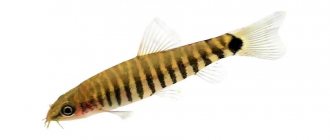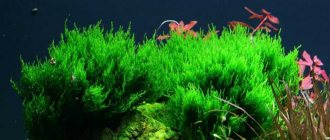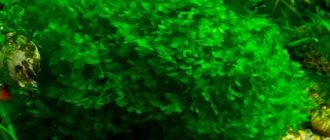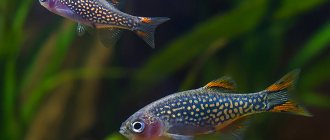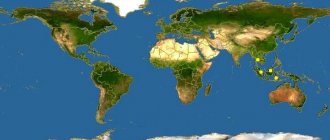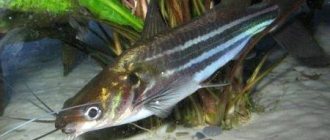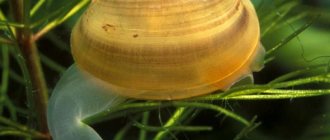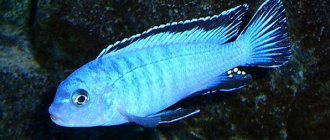A pond with nymphs (water lilies, water lilies) is a spectacular decoration for any area. And some forms of this plant can bloom well even in a bucket of water. We will introduce you to popular varieties and tell you how to care for these flowers.
The charming nymphaeum got its name in honor of nymphs - spirit girls from ancient Greek mythology who personify nature. This perennial plant has unusual round or heart-shaped leaves and large (double or simple) star-shaped or cup-shaped flowers. They can be snow-white, cream, yellow, orange, pink, peach, burgundy, red, blue.
Nymphs can be divided into 3 groups: dwarf, medium-sized and large. The latter have very large flowers (about 25 cm in diameter), so they are rarely found in summer cottages, because such giants require a large lake.
Nymphea dwarf
Dwarf nymph photo
Dwarf nymph Santarem (Nymphaea sp. “Dwarf”, Santarem) grows under natural conditions in water bodies of South America, Brazil and Venezuela. The plant appeared relatively recently on the domestic market and therefore can very rarely be found in aquarist collections.
Dwarf nymph photo
Nymphea dwarf generally lives up to its name - it is small in size and has round leaves. Depending on the conditions of detention, the leaves can have different colors - green or beige with small spots of red. The leaves of the nymphea are located almost horizontally, and the tip of the bush is bent downwards. The maximum height of the bush reaches 10 cm. In acceptable conditions, Nymphaeum santaram grows very quickly and forms dense thickets, under which the ground is completely invisible.
Water parameters for keeping dwarf nymphs: temperature 22-26°C, hardness dH 2-10°, acidity pH 5.5-8.0. Feeding with macro and micro fertilizers is necessary. Bright lighting with an intensity of at least 50 Lm/l is required. Daylight hours are 8-12 hours a day.
The soil must be nutritious. It is advisable to place a substrate or Tetra Planta Crypto . In this case, the growth rate of the plant increases significantly, and the color of its leaves becomes brighter.
The dwarf nymph has a very decorative appearance and can decorate almost any aquarium. But it does not tolerate long-term transportation and transfers well. The aquarist should make efforts to quickly adapt the plant.
Dwarf nymph photo
Nymphea in the aquarium video review
PRACTICAL NOTE ON GROWING AQUARIUM PLANTS
This note is posted in all FanFishka articles dedicated to aquarium plants. This is a cheat sheet with a link that will help you grow any aquarium plant and herbalist of any complexity.
First of all, the proper level of lighting is necessary.
(light intensity - Lumens)
Next, the proper concentration of CO2
Further macro-fertilizers and micro-fertilizers
Water parameters, care and quality water changes
The gradation of this formula is based on the degree of importance. Lighting intensity is primary, and then descending. Therefore, if your plants have holes in the leaves, they have sciatica (crooked) or there are problems with algae, then please do not read the “bad advice” - this is chlorosis (lack of iron), this is a lack of potassium... diarrhea, phimosis and endometriosis )
You always need to solve the problem of setting up an herbalist from major to minor. Plants will die more quickly from a lack of lighting than from a lack of Fe and K. Moreover, the latter are always present in one degree or another in the aquarium, but it is difficult to measure their precise value.
Below, let's go from the main to the minor.
Lighting in an aquarium with plants . Remember, the most important thing in light is its intensity (Lumens)! All other lighting characteristics: spectrum, Kelvin, PAR/PAR, Ra... are important, but secondary. There will be no intensity of lighting, there will be nothing. At the same time, the lighting intensity must be balanced - selected specifically for your project (height of the water column, number and types of plants, daylight hours).
Based on the above, choose aquarium lighting primarily by the number of lumens, and then everything else.
Lighting is the most expensive part. The most budget-friendly solution is to install ordinary construction-street floodlights above the aquarium . Fortunately, they are now very thin and aesthetic. And believe me, under them everything grows with a bang, of course, provided that all the other components are present.
In order not to be unfounded, here are photos of our herbalists, which were grown exclusively under LED spotlights or with their presence.
If you want professional lighting or aesthetics. Then you will have to fork out some money. The amounts can vary quickly from 10,000 to 50,000+ rubles for a 100 liter aquarium. It’s difficult to advise anything, because... Everyone has different needs and capabilities. In this article we talk about the products of our partners - Tetra , Laguna , ISTA lighting .
We tried to briefly and objectively talk about them. Then it's up to you. In any case, we do not really recommend that you pay attention to handicraft lighting assembly from folk craftsmen. Not all, but as a rule, they shove who knows what kind of diodes into such an assembly, assemble it all on their knees... and believe me, more than once on the forum you hear echoes of the consequences of such a purchase. After all, a company is a company. At a minimum, you are given warranty and post-warranty service.
If you are a beginner, your first herbalist, then LED spotlights are your choice. Let's move on, otherwise this note isn't very short =)
CO2 for aquarium plants . The plant is approximately 90% water, the remaining 10% is dry matter. Of that 10%, 46% is carbon. This is why CO2 supply is so important in a planted aquarium.
Expert advice
Experienced aquarists give the following tips and recommendations for growing nymphs:
- The plant is kept in a large reservoir, since the nymphea is large in size.
- Use soft, well-settled water. If it is hard, the water lily may not bloom.
- In order for the plant to develop well, it must be fed with mineral fertilizers. The lotus especially needs iron.
- The duration of daylight should be at least 12-14 hours.
- Nymphea quickly reproduces by root shoots. They need to be separated periodically, otherwise the bush will become too thick.
- Use shells and stones with caution as they increase water hardness.
- The temperature of water and air must be maintained at the same level. Its jumps are detrimental to the plant.
- The layer of substrate for planting lotus is at least 4-5 centimeters. This is due to the large size of the roots.
- The plant is planted so that the growing point is not buried. Otherwise, the development of the water lily will slow down.
Nymphea is a beautiful plant for a pond. It can be grown not only in a garden pond, but also in a room aquarium. With proper maintenance, the aquarist will admire the large leaves and beautiful flowers of the nymph for a long time.
Dwarf nymphea (Nymphaea sp. “Dwarf”, Santarem)
Dwarf nymphea (Nymphaea sp. “Dwarf”, Santarem)
Post by Alseef » Jun 29, 2021, 9:37 pm
General information on Dwarf Nymphaea (Nymphaea sp. “Dwarf”, Santarem):
Family: Water lilies (Nymphaeaceae) Origin: South America Difficulty: Easy Conditions: Strong-very strong lighting, 10-12 hours. Temperature 18-26°C, dH 2-10°, pH 5.5-8. Height 10 cm. Growth rate: High
Additional information on Nymphaea sp. “Dwarf”, Santarem:
Nymphaea sp. “Dwarf” Santarem generally lives up to its name. The plant is small in size and has round leaves. Depending on the conditions of maintenance, the leaves of the plant can have different colors - green or beige with small spots of red. In some cases, the plant produces small floating leaves, which generally do not spoil the positive impression of it. The leaves of the nymphea are located almost horizontally, and the tip of the bush is bent downwards.
Under acceptable conditions, dwarf nymphea grows very quickly and forms dense thickets, under which the ground is completely invisible. Under acceptable conditions the growth rate is very high. It should be noted that the greatest effect in an aquarium can be achieved by not allowing the plant to fill the entire bottom area. The dwarf nymph will look most decorative if you give it no more than half of the entire area of the aquarium to grow. The soil should be nutritious and well silted. It is advisable to place lumps of clay under the roots. In this case, the growth rate of the plant increases significantly and the color of its leaves becomes brighter.
Nymphea dwarf reproduces like Echinodorus tenderus and Vallisneria by stolons. It looks like this - roots spread out in different directions from the mother bush under the ground, at the nodes of which adventitious roots first form, and subsequently a young shoot appears. Young bushes grow literally before our eyes. The plant can also bloom by releasing a flower arrow at the end of which a small bud is formed, which during the ripening process increases several times in size and eventually a white flower opens.
Nymphea - the best varieties with photos, planting and care
Adding an article to a new collection
A pond with nymphs (water lilies, water lilies) is a spectacular decoration for any area. And some forms of this plant can bloom well even in a bucket of water. We will introduce you to popular varieties and tell you how to care for these flowers.
The charming nymphaeum got its name in honor of nymphs - spirit girls from ancient Greek mythology who personify nature. This perennial plant has unusual round or heart-shaped leaves and large (double or simple) star-shaped or cup-shaped flowers. They can be snow-white, cream, yellow, orange, pink, peach, burgundy, red, blue.
Nymphs can be divided into 3 groups: dwarf, medium-sized and large. The latter have very large flowers (about 25 cm in diameter), so they are rarely found in summer cottages, because such giants require a large lake.
Use on the farm
Water lilies are used on the farm for various needs.
For example, rhizomes are used for food . Cut into slices, dry, grind to flour. Next, they are washed and used for baking bread and flatbreads.
For acute respiratory infections, the roots of the flower are used as mustard plasters . And decoctions and infusions are used in the treatment of malignant tumors. The decoction also has a calming effect on the central nervous system.
For its hemostatic properties, it is often used for wounds . Soothes and reduces pain. The rhizomes are also used for inflammatory processes on the skin.
reminiscent of coffee is prepared from the seeds of nymphea For insomnia and neuroses, healers use it as a sedative.
And for rheumatism and neuralgia, water lily is used as an analgesic, and for fever as a mild antipyretic.
However, the use of the plant for medicinal purposes should be careful, especially when taking decoctions and infusions, as it significantly lowers blood pressure.
It is imperative to consult a competent doctor and obtain his permission to self-medicate with this plant.
Water lily is used in cooking and folk medicine
Dwarf varieties of nymphs
These babies are successfully grown in a tub or bucket. If desired, for the winter they can be brought into a room with an air temperature of at least 20°C and with good lighting, then the nymphs will delight you with their flowering even in the cold season.
The most popular dwarf varieties are Pygmaea Alba and Pygmaea Helvola. For them, it is enough to organize a pond with a depth of 10 to 40 cm. These nymphs have a flower diameter of 5-10 cm.
Slightly larger varieties - Aurora, Little Sue, Perry's Baby Red, Laydekeri Lilacea - are distinguished by flowers with a diameter of 10-20 cm, growing at a depth of 20-50 cm.
In the first year they develop well in a three-liter container, but in the second year they need to be transplanted into a larger container.
Beautiful pond decoration
There is a beautiful legend about green tea and white water lily . If you place green tea in a blooming flower at dawn and collect it at the end of the day, then drinking it, a person will gain the necessary vitality.
If a water lily has settled in your pond , then an interesting solution would be the appearance of fish in it. Fish not only decorate the pond, but also serve as good helpers for flowers.
The most popular fish will be Koi carp and comets. They are extraordinarily beautiful. Comets are more mobile and live in the upper layers of the reservoir; moreover, they do not disturb the flowers. And carp are more fussy, rushing around in plants and making a mess.
If the reservoir is large (2-3 meters deep), then carp will fit into the picture better. If the body of water is small (up to 70 centimeters), then opt for a comet.
Medium-sized varieties of nymphs
Medium-sized water lilies have a flower diameter of 15-20 cm. They are planted in a small lake or artificial reservoir to a depth of 30-40 cm. Such water lilies occupy from 1.2 to 1.5 sq.m of water surface.
Medium-sized nymphs are distinguished by a huge variety of varieties with flowers of different colors. These aquatic plants bloom from early summer until frost.
The most popular varieties of this group: Gonnere, Pink Dawn, Lemon Meringue, Hidden Violet.
How to plant a nymph
When planting, consider the depth of the pond or container. If the depth of the pond for the nymph is about 70 cm, then the planting depth should be 50 cm. In addition, the foliage floating on the surface of the water should occupy no more than a third of the water surface. If the pond is completely overgrown with lilies, then you will end up with a flowerbed, not a pond. And the pond looks better when there are stripes of water between water lilies of different varieties, so don’t plant the flowers too close.
Water lilies do not like fast flows or sudden fluctuations in water levels, so do not plant them near fountains.
The easiest way to grow a nymph is from a division (part of a rhizome with a bud). In this case, each of the divisions is planted in a separate container (a container or a black plastic basket) with small holes in the walls. For dwarf varieties, a wide and not very high basket of 5 liters is suitable, and for large ones - 10 liters.
A mixture of clay, sand and garden soil (in a ratio of 2:1:1) is suitable for planting water lilies. You can add special fertilizer for the pond (according to the instructions) or bone meal.
Water is added to the substrate until it reaches the consistency of thick sour cream, after which a division of the nymph is planted in it, and the soil is sprinkled with pebbles (2 cm layer) on top, without covering the growth point. Then the container with the planted water lily is placed in a pond or bucket (when growing dwarf specimens).
It is recommended to plant nymphea in May, then already in July the first few flowers will appear on the plant. At the same time, every 3-4 years the bushes need to be divided and replanted, since due to crowding they stop blooming.
Secrets of success
It is better to transship the nymphaeum rather than replant it. This is done when the rosettes of leaves extending from the rhizome become crowded.
IN THE PHOTO: A new container is selected for Nymphea, one and a half to two times larger than the previous one.
In order for Nymphaeums to bloom magnificently and annually, the rhizomes are divided every four years. In this case, parts of the roots are constantly sprayed. Even short-term drying should not be allowed.
To preserve the decorative appearance and health of the plant, you need to constantly remove old, brown or yellowed leaves. When removing faded flowers, they are cut off with the peduncle.
Nymphea overwinters without problems in reservoirs below the freezing point, at a depth of a meter and a half. When the water in the pond is drained for the winter, the rhizomes of Nymphaeums are covered with fallen leaves. If the rhizomes are buried in the soil for the winter, a thick layer of snow is poured over them.
